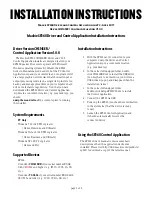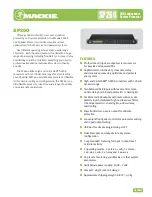
Intel
®
Xeon
®
Processor C5500/C3500 Series and LGA1366 Socket
August 2010
Thermal/Mechanical Design Guide
Order Number: 323107-002US
48
Thermal Specifications
6.2
Processor Thermal Features
6.2.1
Processor Temperature
A new feature in the Intel
®
Xeon
®
processor C5500/C3500 series is a software
readable field in the IA32_TEMPERATURE_TARGET register that contains the minimum
temperature at which the TCC will be activated and PROCHOT# will be asserted. The
TCC activation temperature is calibrated on a part-by-part basis and normal factory
variation may result in the actual TCC activation temperature being higher than the
value listed in the register. TCC activation temperatures may change based on
processor stepping, frequency or manufacturing efficiencies.
Note:
There is no specified correlation between DTS temperatures and processor case
temperatures; therefore it is not possible to use this feature to ensure the processor
case temperature meets the Thermal Profile specifications.
6.2.2
Adaptive Thermal Monitor
The Adaptive Thermal Monitor feature provides an enhanced method for controlling the
processor temperature when the processor silicon reaches its maximum operating
temperature. Adaptive Thermal Monitor uses Thermal Control Circuit (TCC) activation
to reduce processor power via a combination of methods. The first method (Frequency/
VID control) involves the processor adjusting its operating frequency (via the core ratio
multiplier) and input voltage (via the VID signals). This combination of reduced
frequency and VID results in a reduction to the processor power consumption. The
second method (clock modulation) reduces power consumption by modulating (starting
and stopping) the internal processor core clocks. The processor intelligently selects the
appropriate TCC method to use on a dynamic basis. BIOS is not required to select a
specific method (as with previous-generation processors supporting TM1 or TM2).
The Adaptive Thermal Monitor feature must be enabled for the processor to be
operating within specifications.
The temperature at which Adaptive Thermal
Monitor activates the Thermal Control Circuit is not user configurable and is not
software visible. Snooping and interrupt processing are performed in the normal
manner while the TCC is active.
With a properly designed and characterized thermal solution, it is anticipated that the
TCC would only be activated for very short periods of time when running the most
power intensive applications. The processor performance impact due to these brief
periods of TCC activation is expected to be so minor that it would be immeasurable. An
under-designed thermal solution that is not able to prevent excessive activation of the
TCC in the anticipated ambient environment may cause a noticeable performance loss,
and in some cases may result in a T
CASE
that exceeds the specified maximum
temperature and may affect the long-term reliability of the processor. In addition, a
thermal solution that is significantly under-designed may not be capable of cooling the
processor even when the TCC is active continuously.
The duty cycle for the TCC, when activated by the Thermal Monitor, is factory
configured and cannot be modified. The Thermal Monitor does not require any
additional hardware, software drivers, or interrupt handling routines.
The following sections provide more details on the different TCC mechanisms used by
the Intel
®
Xeon
®
processor C5500/C3500 series.
















































